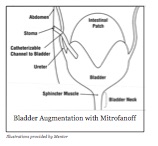What Is Mitrofanoff?
The Mitrofanoff procedure was developed to help patients who are incontinent of urine and experience wetting. The doctor uses the appendix or a small piece of bowel tissue to make a new passageway for urine to come out. One end of the passageway attaches to the bladder, and the other to an opening in the belly button or abdomen. This opening is called a stoma. Patients insert a catheter through the stoma and into the bladder to drain urine.
When is Mitrofanoff procedure used?
At Gillette, this operation is performed most often on patients who have spina bifida or spinal-cord injuries, conditions that prevent good bladder and bowel control.
Many patients already use a catheter, inserted through the urethra, to drain urine. Some find this method of drainage difficult because:
- The urethral opening is difficult to access.
- It’s uncomfortable.
- Physical abnormalities of the urethra prevent catheterization.
Other patients don’t perform regular catheterizations and must wear protective undergarments due to frequent wettings. The Mitrofanoff procedure may help these patients gain greater control over their bladder routines.

Who has the most success with Mitrofanoff?
Success following a Mitrofanoff procedure depends greatly on careful patient selection. Good candidates for the Mitrofanoff procdure are those who are physically capable and emotionally ready to handle a strict routine of intermittent catheterization. Or, they are people whose caregivers are motivated to follow the routine.
A guide to before, during and after Mitrofanoff procedure
After a day or two of home bowel preparation, you’ll be admitted to the hospital the day before surgery to continue
cleaning your bowel. A tiny tube called a nasogastric tube (NG) will be placed through the nose and into the stomach. The tube is used to give medicine that will clean out your intestine
Your hospital stay will last between five and seven days. For the first two to three days following surgery, you won’t be able to eat or drink. During your hospital stay and for up to six weeks after you go home, at least one catheter will remain in your bladder to drain urine (through the urethra or the abdominal stoma).
When you return to the hospital to have your catheter(s) removed, a doctor or nurse practitioner will teach you how to catheterize your bladder through the stoma. If you’ve also had bladder augmentation you’ll be taught how to irrigate (flush out) you bladder to prevent mucous build-up.
After you’ve healed completely, you’ll follow a strict routine, draining the bladder at least every four hours and irrigating the bladder at least once a day.
This information is for educational purposes only. It is not intended to replace the advice of your health care providers. If you have any questions, talk with your doctor or others on your health care team.
If you are a Gillette patient with urgent questions or concerns, please contact Telehealth Nursing at 651-229-3890.
 Home Page
Home Page
